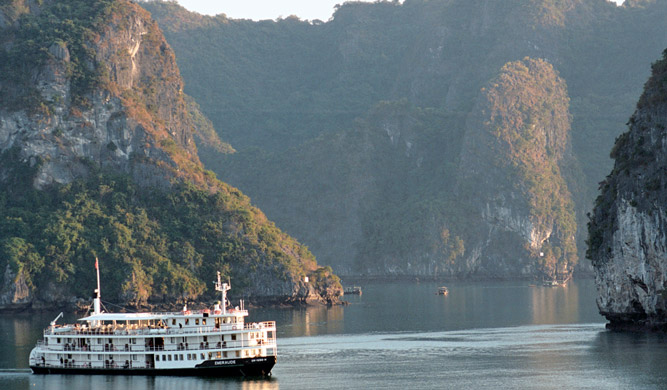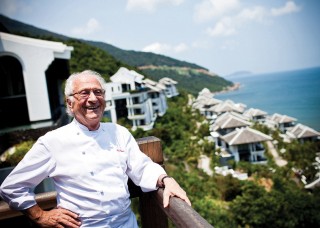Above: An Emeraude cruise in Halong Bay.
Can a raft of new environmental initiatives save Halong Bay?
By Christopher R. Cox
In a scene straight out of Indochine, a near-replica of a French-colonial paddle steamer threads through the islet-studded dreamscape of northern Vietnam’s Halong Bay, a watery maze of precipitous limestone outcroppings. One final turn and the S.S. Emeraude enters a cove below Bo Hon Island, the site of Surprise Cave, one of the world-famous bay’s most popular attractions.
The real surprise, however, is the shabby condition of these now-troubled waters. A flotilla of tour boats clog a small dock below the cave’s entrance, where passengers are beset by local fishermen in rowboats trying to hawk seashells, squid, and small fish they’ve pulled from the bay. Elsewhere, mats of floating trash bob atop the opaque waters.
“Sometimes it’s very, very bad,” observes the Emeraude’s captain, Jacques Le Fur, a world-weary Frenchman who first came to Vietnam more than 40 years ago to skipper cargo boats along the war-wracked Mekong River. “We’ve complained. Sometimes there is too much garbage. It comes from other boats and the villages on the shore.”
Iconic Halong Bay may be one of the 28 global finalists in the New 7 Wonders of Nature campaign (Australia’s Great Barrier Reef and Ecuador’s Galapagos Islands are some of the other contenders), but its beauty is waning. A multitude of problems—mass tourism, coral-reef destruction, mangrove deforestation, and especially pollution—have caused serious environmental damage to this ostensibly protected corner of the Gulf of Tonkin, 160 kilometers east of Hanoi.
Shaped by millions of years of water erosion, the 1,600-plus islands and islets of Halong Bay represent the finest example of a karst seascape on the planet. They also teem with biodiversity: hundreds of fish species have been recorded here, while the forests of Cat Ba Island are home to the endemic golden-headed langur, one of the world’s rarest primates. Because of its unique geology, the bay’s core zone—some 1,500 square kilometers —was listed as a UNESCO World Heritage Site in 1994.
But that exalted status hasn’t immunized Halong from a host of man-made problems. Since its UNESCO inscription, tourist arrivals have increased tenfold. In 1996, the bay welcomed 236,000 visitors; last year, according to the Halong Bay Management Department (HLBMD), the Vietnamese agency overseeing the site, the figure stood at 2.4 million people, including 238,000 passengers who spent the night on the water.
Approximately 400 tour boats ply the bay and are generally restricted to the eastern third of the protected area. About a quarter of this number is permitted to moor overnight, using one of four designated anchorages. Boats also cluster around the handful of sandy beaches and the few large grottoes that have been opened for tourism. Despite its three vast chambers, even Surprise Cave experiences long queues of visitors.
“The challenge is to find a balance between the claims of economic development and the imperative of protecting the environment, which is, incidentally, critical to the health of the region’s tourism industry,” says Hanoi resident David Brown, a former project leader for British NGO Fauna and Flora International.
The most visible culprit is the number of tour boats. While properly equipped vessels such as the Emeraude don’t discharge sewage or toss rubbish overboard, many others are known to dump directly into the bay. In 2008, the provincial government of Quang Ninh, where Halong Bay is located, temporarily banned the construction of new boats. Authorities have since sought to keep substandard craft off the water, though enforcement remains uneven: last year, five passengers drowned in Halong Bay when their three-deck cruiser capsized at night after being caught in a storm. The newly built boat was neither insured nor licensed to operate after dark.
In the shallower northern part of the bay, which is only a few meters deep, the propellers of all these boats kick up silt, greatly increasing water turbidity. This problem is compounded by cargo-ship traffic that cuts through the protected zone to enter the busy port of Cai Lan, just east of Halong City, and by the periodic dredging required to maintain a navigable channel for these deeper-draft vessels.
“The silt that was thrown up by dredgers delivered the coup de grâce to the bay’s coral reefs,” Brown explains. “The disturbance could have been minimized if the channel had been dug rather than just plowed.” Surveys completed in 2007 determined that over 90 percent of the bay’s three dozen reefs were dead or dying, primarily due to lack of sunlight. Only a few soft-coral species seemed able to tolerate the murky conditions, and none were thriving. The reefs might have had a chance, but their demise was accelerated by the destruction of much of the mangrove forest fringing the northern reaches of the bay. These hardy, saltwater-tolerant trees are characterized by their tangle of prop roots, which trap sediment, mitigate shoreline erosion, and serve as a nursery for juvenile fish and shrimp. In 1991, mangroves covered 25,000 hectares around Halong Bay; as of five years ago, Brown says, only 9,000 hectares survived, the consequence of a shortsighted attempt at commercial shrimp farming and extensive land-reclamation projects for industrial, residential, and tourism development.
Because of the widespread loss of reefs and mangroves, coupled with a history of unsustainable fishing practices, the bay no longer supports a large fishery, aside from squid. Residents of Halong’s four floating villages continue to scour the waters for anything that swims, using the catch as feed for small-scale fish farms. But Brown and others aren’t assigning major blame to these communities, or even the tour boats, whose impact is relatively small.
“Our problems come from upstream,” Le Fur says.
Less than an hour’s drive inland is a major coal-producing area centered on Uong Bi, a town entirely stained with soot. Residential refuse and heavy-metal leachates wind up in rivers that ultimately discharge into the bay, where, until recently, this toxic stew mixed with spillage from a coal-loading facility.
Still, there is reason to hope that Halong Bay won’t be entirely ruined. Up until 2005, the provincial government insisted that economic growth on the mainland wouldn’t affect the World Heritage Site. New leadership has since acknowledged the problems, Brown says, and has taken steps to control development and upgrade waste management.
The coal port has been relocated outside the protected area, while dredging operations now dig up sediment and remove it by barge. The HLBMD has also limited construction of new houses in the floating villages and installed garbage-collection units.
The most beneficial long-term impact may come in the form of the Eco-Boat Project, launched by Fauna and Flora International and the HLBMD with funding from the Darwin Initiative, which supports biodiversity conservation in developing countries. Essentially a floating classroom, the boat delivers an environmental- awareness program to the communities along the bay, which are home to one million people.
“This is a fruitful toolkit for education and outreach, as it gives teenagers a chance to experience ecologically practical exercises,” says HLBMD vice director Nguyen Cong Thai.“It’s a beginning,” Brown concedes, “but inevitably, the bay is going to remain under pressure from onshore development and from mass tourism.”
Standing at the helm of the Emeraude, Le Fur says the situation “is not perfect, of course. But education will help, and that takes time.” For now, the captain has a more pressing concern: making safe passage through a swarm of erratically darting watercraft. “They drive boats like they drive motorbikes,” Le Fur sighs. “The same.”
THE DETAILS:
HALONG BAY
When to Go
Overcrowded or not, Halong Bay remains one of the region’s must-see attractions, besting Guilin in southern China and Thailand’s Phang-nga Bay for its haunting karst scenery. The October–April dry season offers the coolest weather, but it also attracts the most tourists. Aim instead for the months of May through November, when visitor numbers (and prices) are at their lowest. Note, though, that the occasional summer storm or typhoon can prompt authorities to temporarily close the bay to watercraft.
Touring
Splurge for an overnight trip and spend two days exploring the islands with Emeraude Classic Cruises (84-4/3934-0888; emeraude-cruises.com; from US$330, double), which operates a near-replica of a 37-cabin paddle steamer that plied these very waters a century ago. Alternatively, the Halong Ginger (84-4/3933-5561; cruisehalong.com; one-night cruises from US$277, double) is a cut above the bay’s legion of faux-junks, with working sails and cozy en suite cabins. Both outfits can arrange transport for the three-hour drive from Hanoi.
Originally appeared in the June/July 2010 print issue of DestinAsian magazine (“Stemming the Tide”)







